
And in spring we’ll wait for lilacs
Kiona Callihoo Ligtvoet
March 10 - April 22, 2023
“Desire is a refusal to trade in damage; desire is an antidote, a medicine to damage narratives. ”*
And in spring we’ll wait for lilacs is a collection of visits over instant coffee, time spent resting in newly thawed grass after a long winter's sleep, and relatives guiding one another's hands through brambles and soil. Each painting acts as reassurance, that with ease and patience, better days will come. They acknowledge regret as a longing for something different, and remind us of what’s still kept safely and tenderly. Not with the absence of grief, but with acceptance of what’s felt between self-compassion and care.
Through the works, gentle attempts are made at navigating intergenerational loss and longing, in the presence of enfranchisement and personal displacement. Looking to moments and promises that still linger between past and present, the work gives space to the complexities of grief, a gratefulness for visiting home, and exchanges of trust; that each overlapping story that has been sowed will be held, and in spring there will be lilacs again.





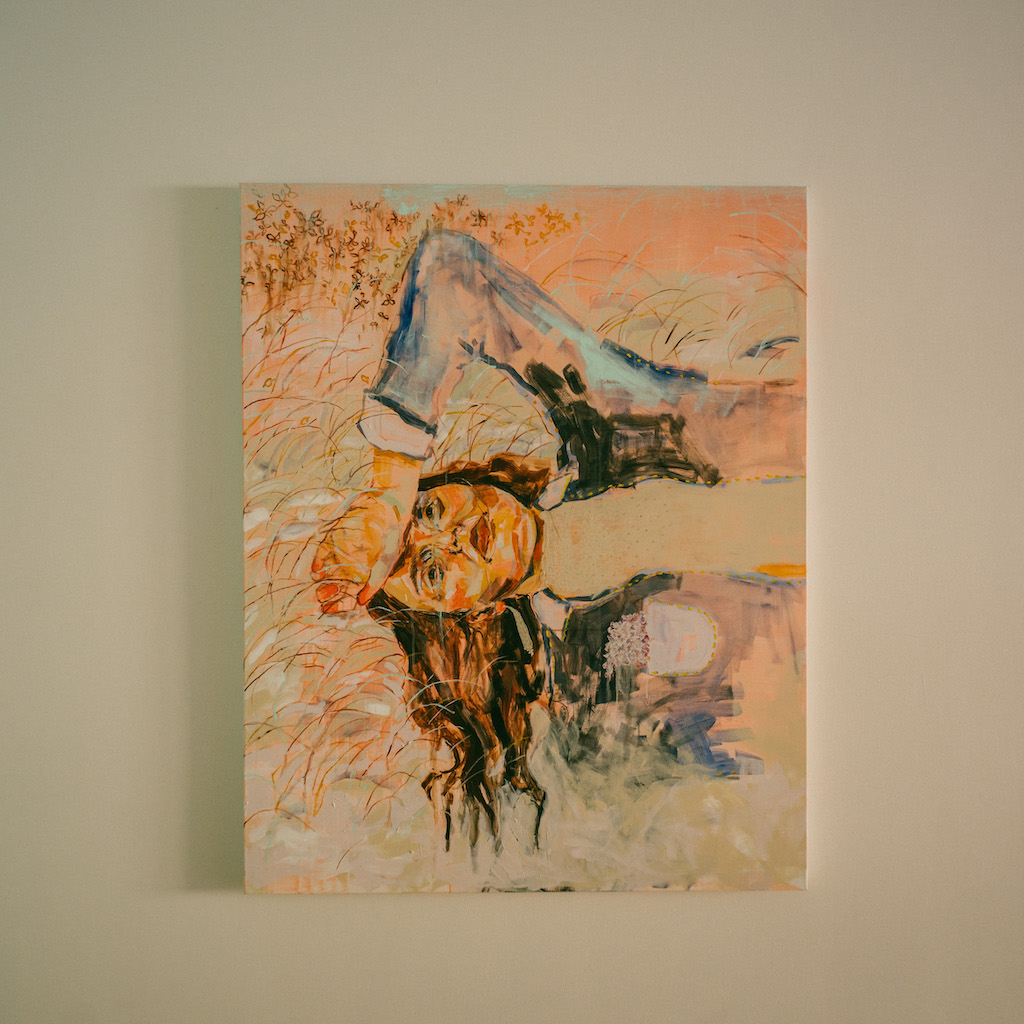



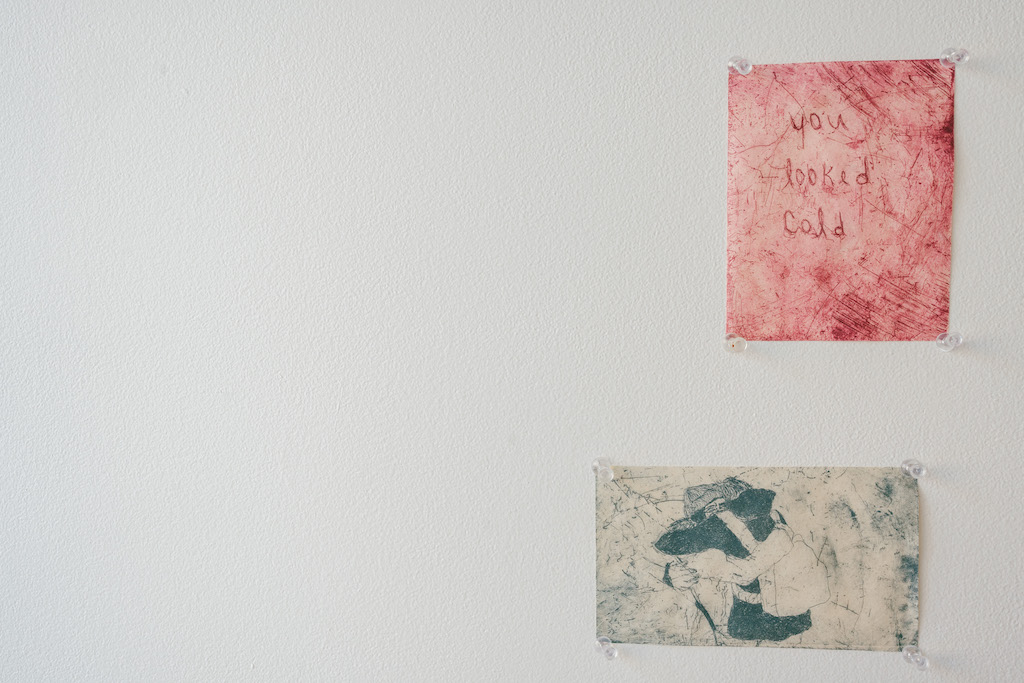

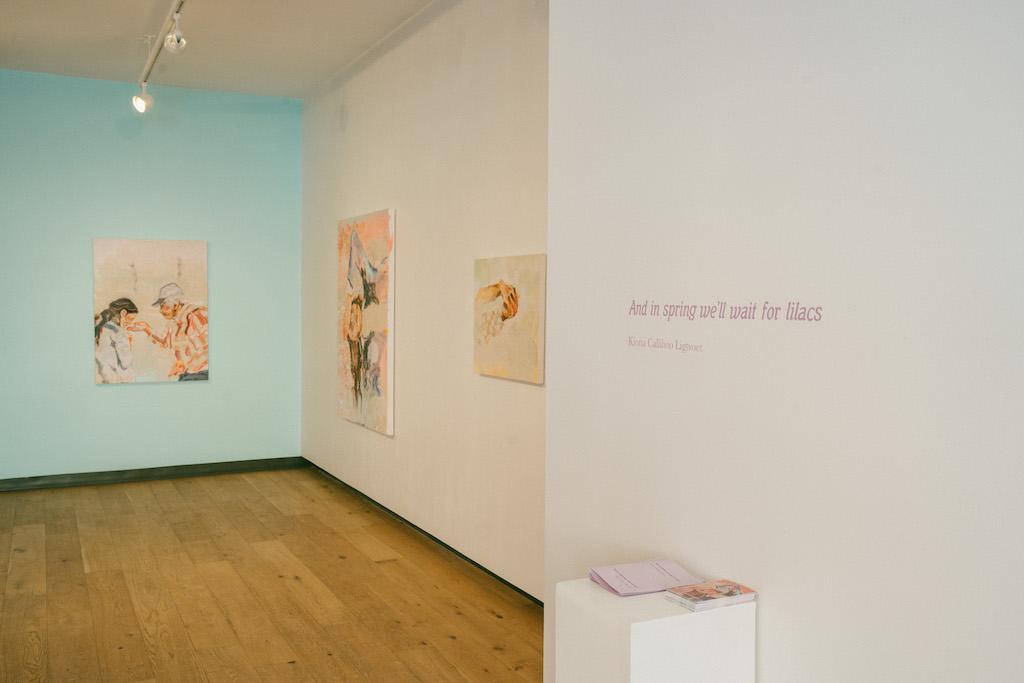
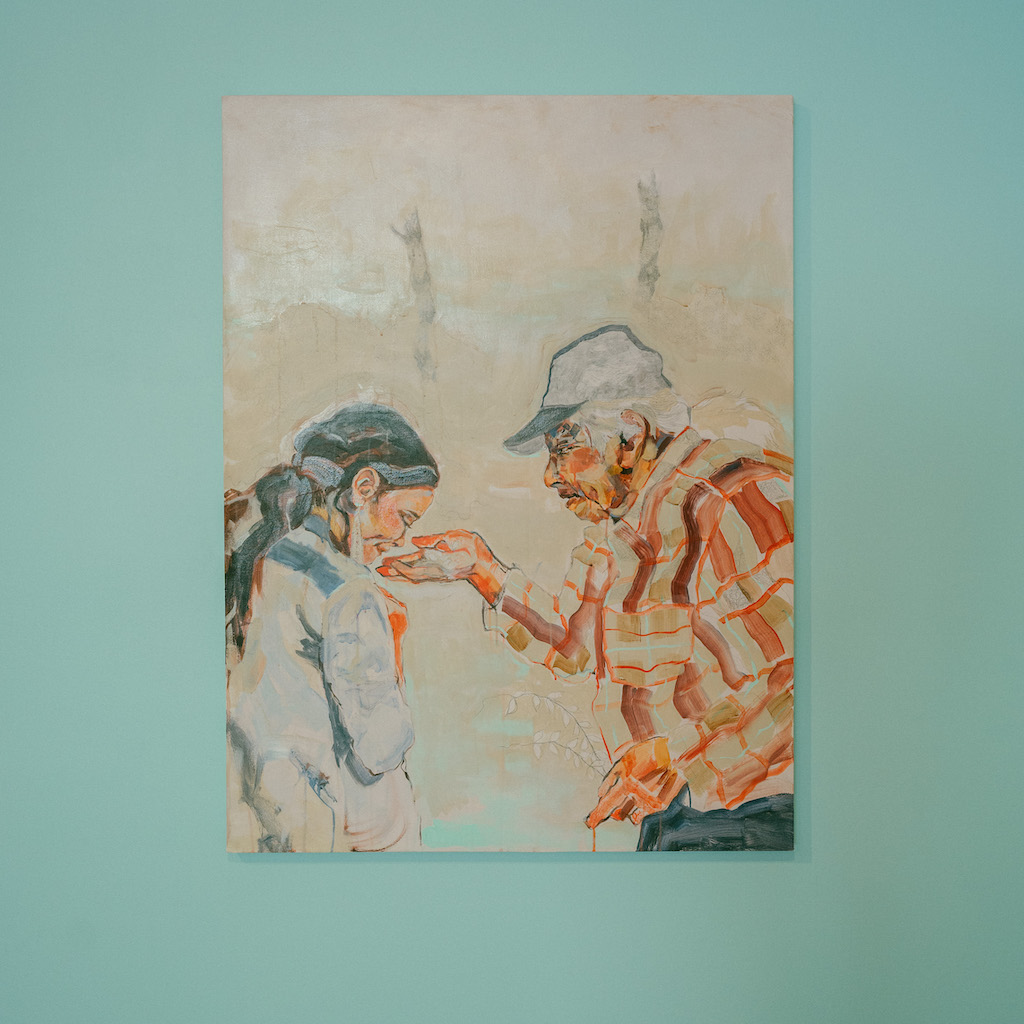
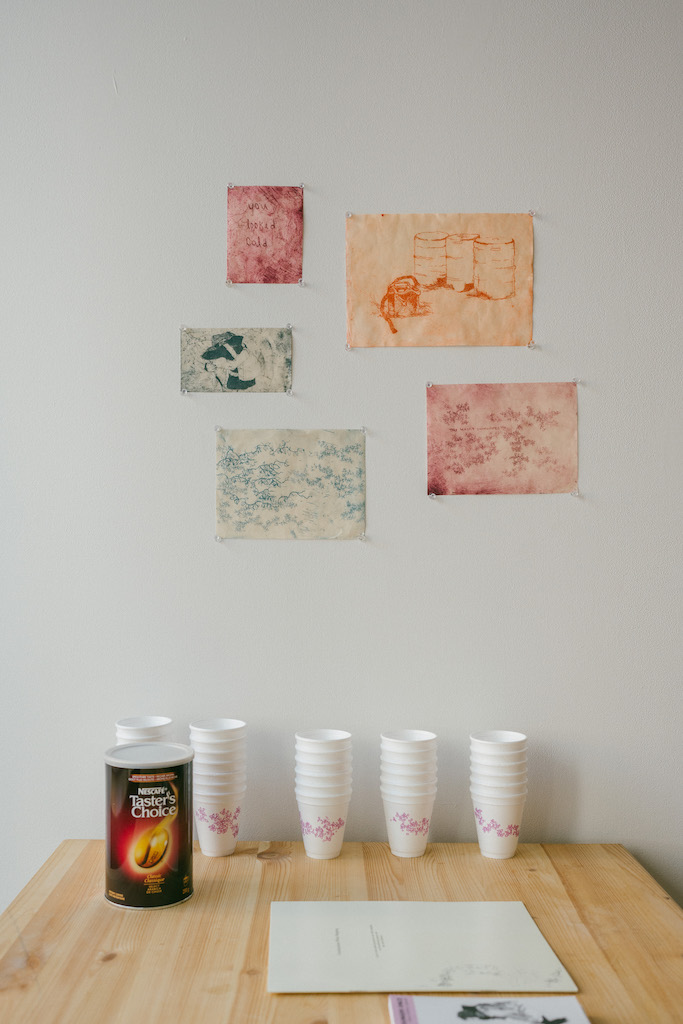

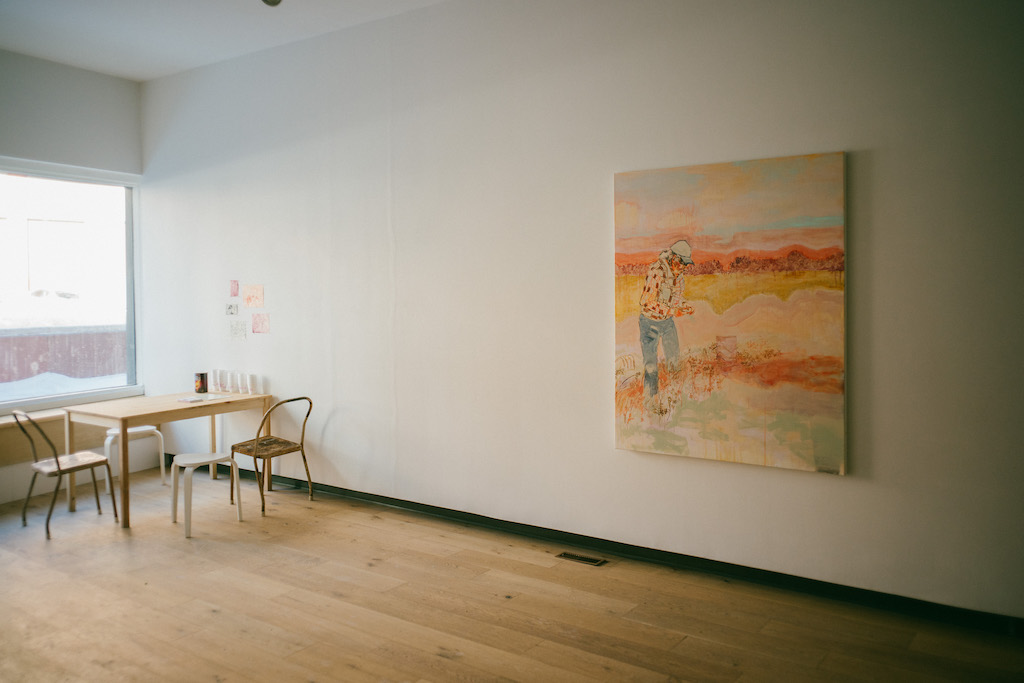


Documentation by Danny Luong
We can hold hands while we wait
Sanaa HumayunI’m writing this on a biting cold March day - Kiona, Jasmine and I spent the day preparing to install her exhibition, And in spring we’ll wait for lilacs. This meant taking a long lunch, picking out the perfect teal paint for the walls, and sitting around a folding table gossiping and sharing stories while waiting for coats of paint to dry; flecks of teal paint staining our hands, clothes, and faces. Kiona and Jasmine’s cackling laughter is the soundtrack to this exhibition text.
Our installation process is informed by the same care and gentleness that runs throughout the exhibition. Kiona is someone who wants to make it comfortable - not just for herself, but for everyone involved in the process. There’s no worry about if things will run on time, if they will look good, if everything will turn out ok. We trust each other to do the best we can, and for that to be enough.
And in spring we’ll wait for lilacs is rooted in trust. This body of work is a reminder that we can trust in each other, to hold and be held, to weather the hard parts together until the load is lighter. Soft, pastel colours run throughout, highlighted by pops of bright blue and orange making everything feel a little dreamy. Despite this dreamy quality, the exhibition rests in the reality of bittersweet tenderness and vulnerability as part of Kiona’s ongoing body of work which explores her relationship to a place she won’t always have access to. Kiona has Cree and Métis family lines, as well as mixed European, and comes from Michel First Nation. The farm she grew up on is the last of the scrip given in exchange for enfranchising Michel First Nation. Her Moshom is the last caretaker of this land, and this place that means so much to her, lives in a tenuous and uncertain balance. Her practice continues to serve as an archive of this place, of the relationships held within it.
From better days in soil and brambles greets you when you walk into the gallery. Her Moshom stands along the wagon trail at the farm, picking mint from the grass. It used to be a marsh, and though the land has shifted over time, some of its habitat is still there. This section borders a field of crops, and they can see where the pesticides have spread, a stark line where the mint no longer flourishes. Kiona’s work thrives in the details. The quiet focus on her Moshom’s face as he rubs the mint in his hands sits in contrast to the vaguely defined details in the background. Brambles weave around his feet, a familiar imagery found throughout her work. Her shadow is vaguely defined in the corner of the piece, reaching to meet his.
As always, Kiona’s work rewards you for looking. In This is where you’ll find me, the emotions lie in the details. The brambles have a visceral, raised texture, both painted and carved into the canvas. Above her translucent hands sits ghostly text, “if I pass on and haunt a place this is where you’ll find me”. The grief in this piece is apparent in the dripping lines of paint from Kiona’s hands, the rough and raised texture of the brambles. The farm has always been a place that’s made space for grief and loss; through the history of enfranchisement, through the way the surrounding land has changed, through Kiona’s relatives that have passed with her last memories of them being on this land. Making space for this grief creates space for comfort too. Though the future of the land is uncertain, it will always exist in some way or another. She can always come home, and when she passes she’ll remain here, and there’s comfort in that thought too.
In Mint Picking, she brings us back to walking on the farm, collecting mint. The tall grass is full of leaves and to find the mint, her Moshom rubs the leaves against his fingers and smells for mint. She paints a tender moment between them as he holds the mint for her to smell. When she leaves the farm her fingers smell like mint for the rest of the day.
And in spring we’ll wait for lilacs hurts to look at for too long. It pokes at the most hidden parts of my heart, the things I struggle to share, the vulnerabilities and endings, it reminds me of finding solace in solitude, a place that feels like home. It feels like a last tethering point when I feel lost. The crisp blue highlights that run throughout, the soft expression on Kiona’s face. This work is the best of Kiona. She describes this work a little hesitantly. It’s a private moment with herself, and one she’s careful to keep close. She describes it as the feeling of laying down in the grass just as it starts to peek through the wet and cold of the thawing snow. It’s finding comfort on the farm, as her body settles into the land and she can finally breathe fully. In the background are lilac bushes. They’re not indigenous to the land, her Moshom and Grammy planted them years ago, and now they grow back every year.
It’s incredibly special to steward and share in the work of someone I care about so much. Every level of supporting this installation has been playful, gentle, and tender. We acknowledge regret and grief, and make space for those things while celebrating ourselves and each other. That’s what Kiona does in this show, for herself, for her loved ones, and for everyone who visits with these stories for a while. I’ve known and loved Kiona for three years. It feels like a lifetime and also has passed in seconds. In three years of laughter, validation, tears and venting, Kiona has shown me again and again that time, love and care soften so many hurts. No matter how hard it feels, knots loosen, time passes, lilacs grow once again. The way I love this show is so deeply informed by the way I love Kiona - I know I’m not objective. I see the fierce care and support that she builds into her life spread across the exhibition, embedded into the processes and the methodologies she uses. I’ve seen her grow and advocate unapologetically for herself and others, I’ve seen her carry her loved ones through their hardest moments, I’ve seen her art practice develop an incredibly raw and genuine visual language that remains rooted in emotion and accessibility. I don’t know how to be objective but I think that’s ok, because this work isn’t objective. It’s not sterilized by its placement in the stiff white walls of an institution. Instead, it brings a softness into a space that doesn’t provide it as a given. It gives you a place to sit at the kitchen table, to curl up with a tea, to rest for a moment.
Through every down, through every dark winter night that feels endless, this work reminds me of what Kiona’s friendship always has - in the spring there are always lilacs once again. We can hold hands while we wait.
Kiona Callihoo Ligtvoet (she/her) is a multidisciplinary artist practicing in amiskwaciwâskahikan on Treaty 6 Territory. She grew up West of the city near the hamlet of Calahoo where she lived with her relatives on scrip land. Her family lines are Cree and Métis descending from Michel First Nation, as well as Dutch and mixed European.
Kiona works in painting, printmaking, and drawing, recollecting personal stories of grief and tenderness. Her practice uses a non-linear telling of her memories through narrative work as a form of diaristic archiving. It draws from feelings of loss and enfranchisement, but also from deep belly laughter, and a gentle fondness for where the histories between herself and her family overlap and disperse.
Working alongside other artists in initiatives of community care, Kiona co-organizes Making Space in partnership with Sanaa Humayun. Kiona likes visiting her moshom on the farm, and gossiping with her mom, relatives, and friends on the prairies :)
PRESS /
On Art: “And in spring we’ll wait for lilacs”, CKUA, Kiona Ligtvoet is interviewed by Lisa Wilton on CKUA’s Traffic Jams. Aired March 15th, 2023.
Artslink - Kiona Ligtvoet on CJSW 90.9fm interview with Kiona Ligvoet about her exhibition And in spring we'll wait for lilacs at The New Gallery. Published March 27th, 2023.
Tuck, E., & Ree, C. (2013). A Glossary of Haunting. In 1250032121 926014821 H. J. Linn, 1250032122 926014821 T. E. Adams, & 1250032123 926014821 C. Ellis (Authors), Handbook of autoethnography (pp. 639-655). Left Coast Press.
中文翻译 Chinese Translation ...
